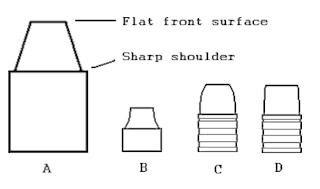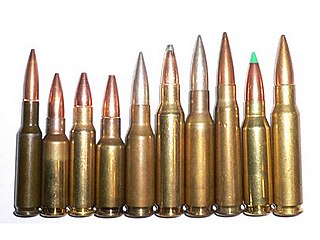Handloading, or reloading, is the practice of making firearm cartridges by assembling the individual components, rather than purchasing mass-assembled, factory-loaded ammunition.

A cartridge, also known as a round, is a type of pre-assembled firearm ammunition packaging a projectile, a propellant substance and an ignition device (primer) within a metallic, paper, or plastic case that is precisely made to fit within the barrel chamber of a breechloading gun, for convenient transportation and handling during shooting. Although in popular usage the term "bullet" is often used to refer to a complete cartridge, the correct usage only refers to the projectile.

The .45 ACP, also known as .45 Auto, .45 Automatic, or 11.43×23mm is a rimless straight-walled handgun cartridge designed by John Moses Browning in 1904, for use in his prototype Colt semi-automatic pistol. After successful military trials, it was adopted as the standard chambering for Colt's M1911 pistol. The round was developed due to a lack of stopping power experienced in the Moro Rebellion in places like Sulu. The issued ammunition, .38 Long Colt, had proved inadequate, motivating the search for a better cartridge. This experience and the Thompson–LaGarde Tests of 1904 led the Army and the Cavalry to decide that a minimum of .45 caliber was required in a new handgun cartridge.

A wadcutter is a special-purpose flat-fronted bullet specifically designed for shooting paper targets, usually at close range and at subsonic velocities typically under approximately 270 metres per second (890 ft/s). Wadcutters have also found favor for use in self-defense guns, such as .38 caliber snubnosed revolvers, due to shorter barrel lengths, lower bullet velocities, and improved lethality. Wadcutters are often used in handgun and airgun competitions.

The .38 Super, also known as .38 Super +P, .38 Super Auto, .38 Super Automatic, .38 Super Automatic +P, or 9×23mmSR, is a pistol cartridge that fires a 0.356-inch-diameter (9.04 mm) bullet. It was introduced in the late 1920s as a higher pressure loading of the .38 ACP, also known as .38 Auto. The older .38 ACP cartridge propels a 130-grain (8.4 g) bullet at 1,050 ft/s (320.0 m/s), whereas the .38 Super pushes the same bullet at 1,280 ft/s (390.1 m/s). The .38 Super has gained distinction as the caliber of choice for many top practical shooting competitors; it remains one of the dominant calibers in IPSC competition.

The .22 Long Rifle or simply .22 LR or 22 is a long-established variety of .22 caliber rimfire ammunition originating from the United States. It is used in a wide range of rifles, pistols, revolvers, and submachine guns.
The .30-06 Springfield cartridge, 7.62×63mm in metric notation, and called the .30 Gov't '06 by Winchester, was introduced to the United States Army in 1906 and later standardized; it remained in military use until the late 1970s. The ".30" refers to the caliber of the bullet in inches, .300 and the "06" refers to the year the cartridge was adopted, 1906. It replaced the .30-03, 6mm Lee Navy, and .30-40 Krag cartridges. The .30-06 remained the U.S. Army's primary rifle and machine gun cartridge for nearly 50 years before being replaced by the 7.62×51mm NATO and 5.56×45mm NATO, both of which remain in current U.S. and NATO service. It remains a very popular sporting round, with ammunition produced by all major manufacturers.

.455 Webley is a British handgun cartridge, most commonly used in the Webley top break revolvers Marks I through VI. It is also known as ".455 Eley" and ".455 Colt".

The Mannlicher M1894 was an early blow-forward semi-automatic pistol.
A rim is an external flange that is machined, cast, molded, stamped, or pressed around the bottom of a firearms cartridge. Thus, rimmed cartridges are sometimes called "flanged" cartridges. Almost all cartridges feature an extractor or headspacing rim, in spite of the fact that some cartridges are known as "rimless cartridges". The rim may serve a number of purposes, including providing a lip for the extractor to engage, and sometimes serving to headspace the cartridge.

The Colt Model 1900 is a short-recoil operated "self-loading", or semi-automatic .38 caliber handgun introduced by Colt's Manufacturing Company at the turn of the 20th century. It also marked the introduction of .38 ACP, the round for which it is chambered, and was the first handgun to utilize short-recoil operation.

Snake shot, rat shot or dust shot, more formally known as shotshell or canister shot by technicality, refers to handgun and rifle cartridges loaded with lead shot canisters instead of bullets, intended for pest control. As the names suggest, the main targets for such ammunition are serpents, rodents, birds and other pests at very close range.

A semiwadcutter (SWC) or flat-nose is a type of all-purpose bullet commonly used in revolvers. The SWC combines features of the traditional round-nosed bullets and the wadcutter bullets used in target shooting, and is used in both revolver and rifle cartridges for hunting, target shooting and plinking. Full wadcutters frequently have problems reliably feeding from the magazines of semi-automatic pistols, so SWCs may be used when a true WC is desired but cannot be used for this reason.

The 6×45mm SAW describes an experimental series of rimless bottlenecked intermediate cartridges developed in the 1970s for the U.S. Army. The cartridges were produced in a variety of sizes and from a variety of materials. The intent was to develop a cartridge that would replace all 5.56×45mm NATO weapons as well as most 7.62×51mm NATO rifles and machine guns in the U.S. military. Eventually, the 5.56mm was retained and only the machine gun portion of the SAW competition was successful. That program led to the M249 light machine gun.

The .45 Auto Rim, also known as 11.5x23mmR, is a rimmed cartridge specifically designed to be fired in revolvers originally chambered for the .45 ACP cartridge.

The 9×25mm Mauser is a cartridge developed for the Mauser C96 service pistol around 1904 by DWM. Mauser pistols in this relatively powerful caliber were primarily intended for export to Africa, Asia, and South America. The 9mm Mauser Export cartridge was produced specifically for Mauser pistols and carbines made from 1904 to 1914 and then later from approximately 1930 to 1945 for submachine guns chambered for this caliber.
The 9 mm Mars is an experimental centerfire pistol cartridge developed in the late 19th century based on necking down the .45 Mars Long case. The bullet has two deep cannelures, and the case is crimped into both. The case mouth is chamfered on the outside to fit flush into the forward cannelure. This elaborate bullet seating was necessary to withstand the violent feed mechanism of the Mars Automatic Pistol. The cartridge headspaces on the shoulder adjacent to the neck. The case has a thin rim and deep extractor groove in comparison to most rimless pistol cartridges. There was a very similar 8.5mm Mars cartridge firing a 139 grain bullet at 1550 feet per second. The Mars cartridges were publicized as the most powerful handgun cartridges through the early 20th century; but less than 100 pistols were made and manufacture ceased in 1907.
The 8.5mm Mars is an experimental centerfire pistol cartridge developed in the late 19th century based on necking down the .45 Mars Long case. The bullet has two deep cannelures, and the case is crimped into both. The case mouth is chamfered on the outside to fit flush into the forward cannelure. This elaborate bullet seating was necessary to withstand the violent feed mechanism of the Mars Automatic Pistol. The cartridge headspaces on the shoulder adjacent to the neck. The case has a thin rim and deep extractor groove in comparison to most rimless pistol cartridges. There was a very similar 9mm Mars cartridge firing a 156 gr bullet at 1,400 ft/s (430 m/s). The Mars cartridges were publicized as the most powerful handgun cartridges through the early 20th century; but fewer than 100 pistols were made and manufacture ceased in 1907.

A cannelure is a groove or channel around ammunition, either bullets or cartridge cases. The cannelure may be pressed into or cast with the bullet or case.













